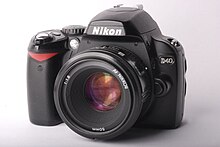Nikon D40
 |
|
| Overview | |
|---|---|
| Type | Digital single-lens reflex |
| Lens | |
| Lens | Interchangeable Nikon F-mount, full function with AF-S and AF-I lenses only. All functions except autofocus supported on all CPU lenses. |
| Sensor/Medium | |
| Sensor | Nikon DX format 23.7 × 15.6 mm CCD |
| Maximum resolution | 3,008 × 2,000 (6.1 effective megapixels) |
| ASA/ISO range | ISO 200-1600, ISO 3200 in high mode |
| Storage | Secure Digital, SDHC up to 32GB |
| Focusing | |
| Focus modes | autofocus: single (AF-S); continuous (AF-C); auto selection (AF-A); Manual |
| Focus areas | 3 sensors, Multi-CAM530 |
| Exposure/Metering | |
| Exposure modes | Manual, Aperture Priority, Shutter Priority, Program and preset settings: Auto, Portrait, Landscape, Child, Sports, Macro, and Night Portrait |
| Exposure metering | 420 segment color meter |
| Metering modes | 3D Color Matrix, Center-weighted and Spot |
| Flash | |
| Flash | i-TTL Built-in or hotshoe (e.g. for the matching SB-400 Speedlight) |
| Shutter | |
| Shutter speed range | 1/4000 to 30 seconds, bulb; 1/500 Flash X-Sync |
| Continuous shooting | 2.5 frame/s, 100 JPEG frames buffer |
| Viewfinder | |
| Viewfinder | optical, through the lens, pentamirror type, 0.8× magnification, 95% coverage |
| General | |
| Rear LCD monitor | 2.5″, TFT, 230,000 pixel, 170° angle of view |
| Battery | 1,000 mAh lithium-ion EN-EL9 |
| Dimensions | 126 × 94 × 64mm (5.0 × 3.7 × 2.5 in) |
| Weight | 475 g (16.8 ounces) without battery 524.1 g with battery 729 g with battery and AF-S DX Zoom-Nikkor 18-55mm f/3.5-5.6G ED II kit lens |
| Made in |
|
The D40 is a now-discontinued Nikon F-mount entry-level digital SLR, announced November 16, 2006. Compared to its predecessor, the D50, the D40 had several features removed, a few added, and a lower price: US$499.95 ESP as of November 2009 with the 18–55 mm G-II kit lens,positioning it as an entry-level model compared to the D80. The D40x (released March 6, 2007) has a 10-megapixel maximum resolution, up from 6 megapixels of the D40 and D50.
The D40 was the first Nikon DSLR without an in-body focus motor. Autofocus requires the use of a lens with an integrated autofocus-motor.
Despite being superseded by newer offerings, the Nikon D40 retained some significant advantages. It enjoyed a long production run which finally ceased in March 2009, shortly before its introduction of its successor, the Nikon D3000.
The Nikon D40 was less expensive than the Canon EOS 400D (also known as the Rebel XTi in the United States), the Pentax K110D, and the Olympus E-400, and is competitively priced against high-end bridge cameras (the D40 and D40x do not have live preview, unlike bridge digitals). It was launched accompanied by a new small kit lens, the AF-S DX Zoom-Nikkor 18–55 mm f/3.5-5.6G ED II. The D40's small size and low price made it attractive to point-and-shoot photographers moving up to their first SLR, however it does contain features and improvements that would appeal to enthusiasts as well.
...
Wikipedia
